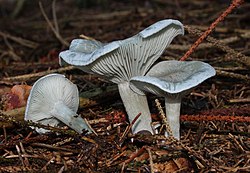| Clitocybe | |
|---|---|
 | |
| Clitocybe nebularis | |
| Scientific classification | |
| Kingdom: | Fungi |
| Division: | Basidiomycota |
| Class: | Agaricomycetes |
| Order: | Agaricales |
| Family: | Clitocybaceae |
| Genus: | Clitocybe (Fr.) Staude (1857) [1] |
| Type species | |
| Clitocybe nebularis | |
| Synonyms [2] | |
Clitocybe is a genus of mushrooms characterized by white, off-white, buff, cream, pink, or light-yellow spores, gills running down the stem, and pale white to brown or lilac coloration. They are primarily saprotrophic, decomposing forest ground litter. There are estimated to be around 300 species in the widespread genus. [3]
Contents
- Taxonomy
- Toxicity
- Selected species
- Taxonomic status unclear
- Reclassified
- See also
- References
- External links
Clitocybe means sloping head.[ citation needed ][ clarification needed ]
A few members of the genus are considered edible; many others are poisonous, containing the toxin muscarine among others. Distinguishing individual species of Clitocybe is generally prohibitively difficult to non-experts, requiring the analysis of microscopic characters. Therefore, with the exception of a few charismatic and readily identified members, Clitocybe mushrooms are rarely collected for consumption.
